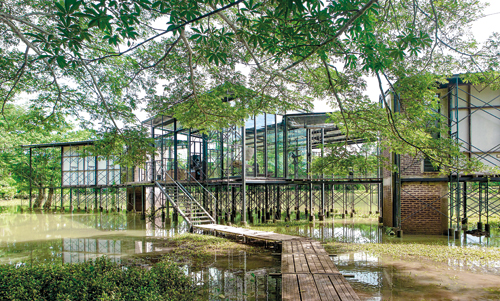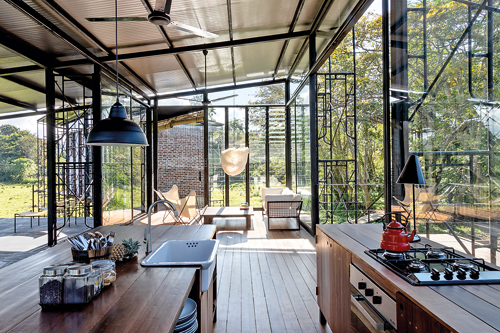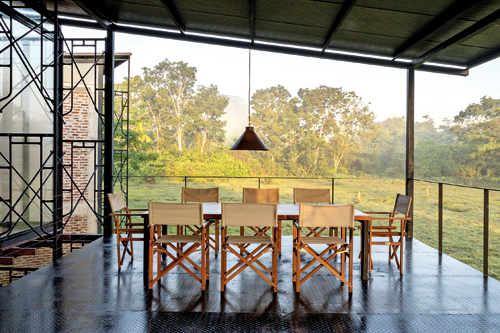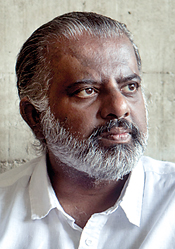Stark house on stilts

Open to nature: The Frame in all its minimalist beauty. Pic by Sameera Weerasekera
It is rare for an architect to have a signature style that could be recognized immediately. Geoffrey Bawa had it, as did Minnette de Silva with her penchant for quaint Kandyan décor and verandahs and courtyards spilling over with tropical foliage- also Valentine Gunesekera with his austere masculine modernism. Though he fumbles for words to encapsulate his work, so does – in a way- Palinda Kannangara.
‘Stark’ is a word to start with- his buildings have that sheer drama of the unfinished and the rough hewn- with great haunting empty spaces like you see at the architect’s studio dwelling in Rajagiriya- like a marriage between the Grand Canyon and the Kandalama Hotel: impressive.
Palinda’s eye for a building that merges with the landscape while being a pleasure in itself is amply reflected in the Frame- a holiday structure that he built for a friend in rural Imaduwa, Galle- now shortlisted for the Geoffrey Bawa Award for Excellence in Architecture 2019/2020.

Custom made furniture: The pantry and beyond, the living space. Pix by Luka Alagiyawanna and Mahesh Mendis
At first sight the structure dawns like something left behind by a construction crew who had mutinied.
But then, you see that the structure – which actually has an exoskeleton of scaffolding – is complete and has grown to be one with the trees and shadows – a very minimal structure that cost only 8 million Rupees (including all furnishings).
The story of the Frame began when Sumudi Suraweera wanted his ancestral property in Imaduwa – 8 acres of land, transformed into a holiday place for the family weekends. Among the challenges was that the land gets flooded almost half the year.
The land is in fact almost an island, surrounded by the Polathumodara River in a dark, lush, almost rainforest like patch in the rich South coast. When he first saw the site Palinda was enchanted by the paradisiacal setting. He knew that, apart from being flood-proof, the new design would have to be raised with a light structure that would not disturb the verdant splendour around.
Permanent scaffolding was the best idea. Holding the floor up at five feet it would withstand the floods- and so the scaffolding was put up on a strip foundation.
Nearly all the design was done onsite, and cost was a top priority. Consequently the economy was done with the most economically available materials in mind. “For example the building line was 8 feet because the external plaster boards come in 8 feet,” smiles Palinda.
There are just three main platforms- and from the sweeping, deck-like living platform in the middle you are open to the wild green villu- bordered in the distance by the most dense kumbuk and para-mara (rain trees) and beyond those a complete ampitheatre of pale blue mountains.
The view from the deck (and the bedrooms) in flood times is that of a lake with emerald banks, with kingfishers darting like streaks of silver shot aqua blue. Flocks of the Black headed ibis, peck at fish and preen their plump pheasant figures, while peacocks trail about picking the path gingerly, their plaintive cries ringing across the water.
In dry season when the Frame stands on tender grass, the village cattle graze right under the building.

Taking in the view: The dining space
Light bridges slant off either side of the living space to two bedroom wings. These have a bathroom each- the only solid structures- the bedroom walls being lightweight, superflex dry walls on timber frame, and the living room being encased in adjustable glass louvres.
The boardwalk leading from the higher ground to the structure was made of scaffolding platforms combined with GI tubes, and the staircase of steel frame and BRC mesh.
The interior is touched with soft creamy luxury- but apart from two butterfly chairs all furniture was studio-made. The lovely low hanging beehive chandelier was made of waste parchment paper, and most of the rest out of leftover timber and steel.
The improvisations include the pantry- with the frame done by the steel contractor then clad with wood so generously available on site. The large coffee table was born the same way. The sofa was made with steel mesh while the base of mattresses were material crates.
“The beauty of it,” says Palinda with paternal affection, “is that it could all be dismantled and placed somewhere else – from the roof down.”
The larger aim of the project, he says, is to test an affordable solution to building in a flood prone landscape and, thus, a solution for flood related natural disasters in Sri Lanka and similar developing countries.
The Frame is also let out to paying guests.
| Know the architect | |
 Palinda Kannangara Soft-spoken and affable with those deep eyes always seeking a new symphony of space, Palinda Kannangara’s work offers a glimpse of someone who sees a world full of awe and mystery. An old boy of Ananda College, he trained under well known architect Anura Ratnavibhushana who had worked under Geoffrey Bawa. In 2005 Palinda established his practice, and since has been known for “experiential architecture that hinges on simplicity, and connection with the natural environment”.Over the 15 years his firm has won several prestigious national and international awards, including an RIBA International Award for Excellence in Architecture 2018, for his studio in Rajagiriya with its atmosphere of a timeless citadel. |


